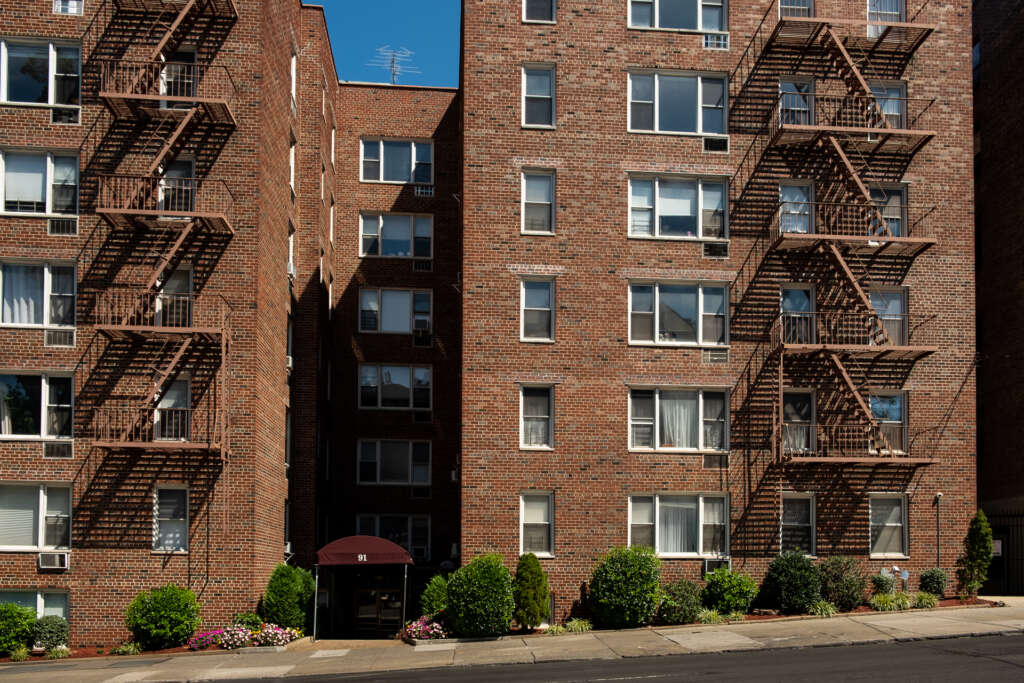A person or family, regardless of their immigration status, could be eligible for the voucher if they don’t have a home or are about to lose their housing, and if they make less than 50 percent of the Area Median Income ($77,650 for a family of four in New York City).
An apartment building in the Bronx. (Photo by Adi Talwar)
After years of calls for a statewide rent voucher program for people experiencing or at risk of homelessness, Gov. Kathy Hochul announced her commitment to launching a pilot program for the Housing Voucher Access Program (HAVP) last week.
While the State and Assembly’s budget proposals sought $250 million for HAVP this year, the state budget deal included just $50 million to cover the first year of the four-year program, which would run from March 1, 2026 and end on May 1, 2030. Funding for the remaining three years will be negotiated in future budgets, officials said.
State Sen. Brian Kavanagh and Assemblymember Linda Rosenthal—who chair their respective houses’ housing committees—sponsored a version of the HAVP bill for the last few years, which shaped the final language included in the budget.
Here’s what we know about how HAVP would work so far, and what is yet to be determined.
Who will be eligible?
A person or family, regardless of their immigration status, could be eligible for the voucher if they don’t have a home or are about to lose their housing. They also need to earn no more than 50 percent of the Area Median Income (AMI). In New York City, that would be less than $77,650 for a family of four, as defined by the U.S. Department of Housing and Urban Development (HUD).
Both Rosenthal and Kavanagh’s offices said it has not yet been determined how much money will go to New York City and other localities, but said the amount may be calculated based on the proportion of severely rent-burdened households in each area.
“Priority shall be given to applicants who are homeless,” reads the budget bill establishing the program’s perimeters. The state Department of Housing and Community Renewal (HCR) commissioner has the discretion to establish further priorities as appropriate, the bill notes.
There were more than 130,000 people in New York City’s shelter system in January, including around 46,000 asylum seekers and immigrants, according to data tracked by City Limits.
Who will be in charge?
HCR will run the pilot program, and will define the specifics and documentation needed to apply. Rosenthal explained that of the $50 million available, 10 percent will go to administrative costs such as outreach, staff, program design, and other materials.
HCR will also coordinate with public housing agencies and local administrators in the state to distribute the vouchers. In the city, it could be the Housing Authority (NYCHA) and the Department of Housing and Development (HPD).
City Limits asked all three agencies for more details about the pilot program, but did not receive additional information beyond what was included in the budget bill.
“I spoke to HPD, and they’re very eager to get started,” Rosenthal said.
How will the vouchers work?
Voucher holders will contribute about 30 percent of their household’s monthly adjusted income on rent, and the voucher will cover the rest. Its value will be set between 90 and 120 percent of the fair market rent for the rental area. The vouchers will remain valid as long as funding is available, Rosenthal explained.
The New York State Child Poverty Reduction Advisory Council estimates that such a voucher program could help reduce poverty across the state.
Like federal Section 8 vouchers, the HAVP administrator will issue payments directly to the owner of the unit under contract. While the Section 8 voucher was used as a model for HAVP, having one of these vouchers excludes having the other, so people can only have one.
New York City also has its own voucher program called the City Fighting Homelessness and Eviction Prevention Supplement (CityFHEPS), to help families move out of shelters and into permanent housing.
More than 55,000 households are receiving CityFHEPS vouchers currently, and the city is projected to spend $1.25 billion on the program this fiscal year—significantly more than the $50 million allocated for the statewide HAVP.
Hochul, who until this year had resisted the proposal, said last month that the state would be “moderating the cost and keeping an eye on the program.”
“This has potential to escalate a great deal,” she told reporters at the time.
CityFHEPS works similarly to Section 8, though has been criticized for lack of consistency in making payments—something state lawmakers are mindful of in launching the new program.
“I think HCR is going to learn the lessons that are blatant through the city’s lack of finesse in administering CityFHEPS,” Rosenthal said. “There are reporting requirements that weren’t in the initial bill that we insisted be attached, so we can get more data and tailor it. See where it’s working, see where it needs improvement.”
What’s next?
Vouchers should be available for use starting March 1, 2026.
The first annual report on voucher pilot implementation should be available on Nov. 1, 2026. It will detail the amount of funding allocated for each county, number of voucher applicants, number of people on waiting lists, number of voucher beneficiaries, and data about the homeless population receiving vouchers, among other data points. A report will be published every year until the pilot program ends.
To reach the reporter behind this story, contact Daniel@citylimits.org. To reach the editor, contact Jeanmarie@citylimits.org
Want to republish this story? Find City Limits’ reprint policy here.
The post Here’s What We Know So Far About New York’s New Housing Voucher Program appeared first on City Limits.

